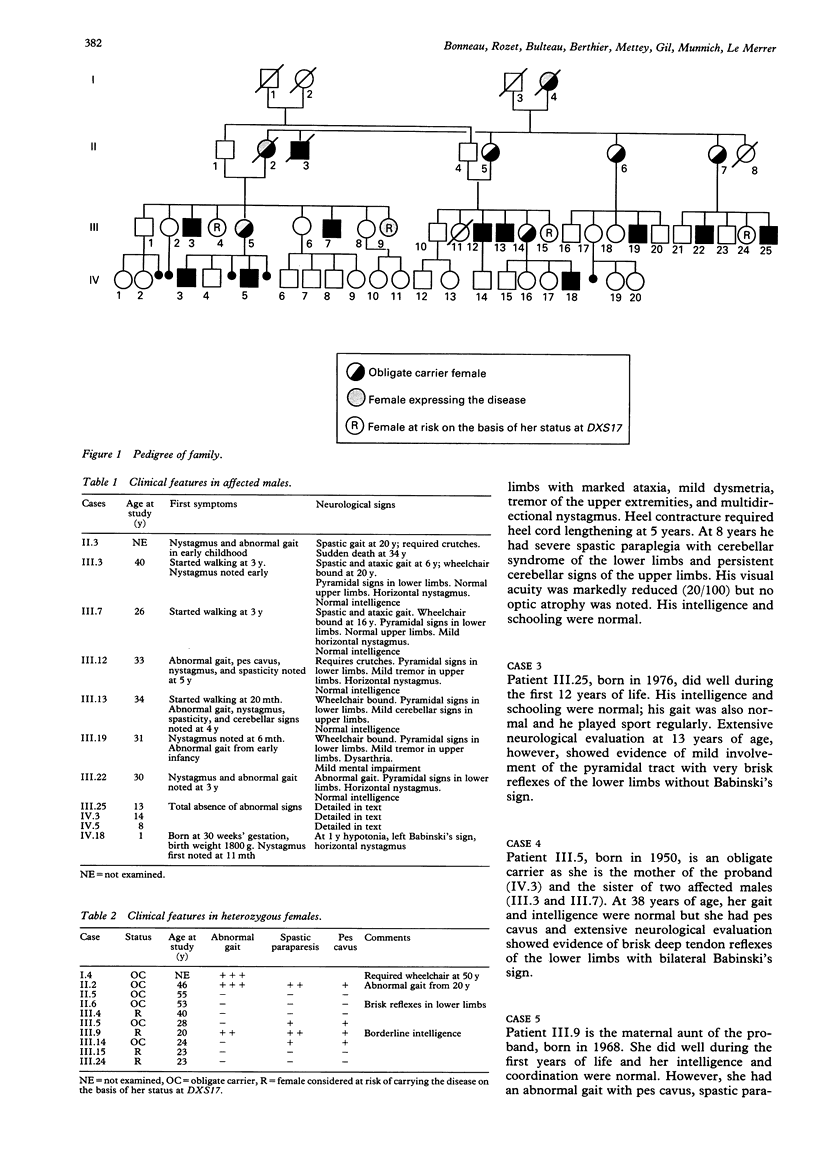Abstract
X linked hereditary spastic paraplegia is a rare condition that has been divided into two forms (the pure spastic form and the complicated form) as a function of clinical course and severity. A gene for pure hereditary spastic paraplegia (SPG2) has been mapped to the proximal long arm of the X chromosome (Xq21) by linkage to the DXS17 locus, while a gene for a complicated form of the disease has been mapped to the distal long arm by linkage to the DXS52 locus (Xq28). Here we report on the mapping of a gene for complicated hereditary spastic paraplegia to the Xq21 region by linkage to the probe S9 at the DXS17 locus (Z = 5 at theta = 0.04) in a three generation pedigree. Multipoint linkage analysis supports the distal location of the disease gene with respect to the DXYS1-DXS17 block (cen-DXYS1-DXS3-DXS17-SPG2-tel). The observation of a complicated form of spastic paraplegia mapping to Xq21 raises the difficult issue of variable phenotypic expression, allelic heterogeneity, or even close proximity of two genes for hereditary spastic paraplegia in this region. However, since our study provides clinical evidence for intrafamilial heterogeneity in complicated X linked spastic paraplegia, the present data support the hypothesis of variable clinical expression of a single gene at the SPG2 locus, as previously suggested for SPG1. Finally, we report here what we believe to be the first evidence of clinical expression in heterozygous carriers, a feature that is relevant to genetic counselling in at risk females.
Full text
PDF



Selected References
These references are in PubMed. This may not be the complete list of references from this article.
- Apak S., Yüksel M., Ozmen M., Saka N., Darendeliler F., Neuhäuser G. Heterogeneity of X-linked recessive (spino)cerebellar ataxia with or without spastic diplegia. Am J Med Genet. 1989 Oct;34(2):155–158. doi: 10.1002/ajmg.1320340203. [DOI] [PubMed] [Google Scholar]
- BLUMEL J., EVANS E. B., EGGERS G. W. Hereditary cerebral palsy; a preliminary report. J Pediatr. 1957 Apr;50(4):454–458. doi: 10.1016/s0022-3476(57)80255-8. [DOI] [PubMed] [Google Scholar]
- Baar H. S., Gabriel A. M. Sex-linked spastic paraplegia. Am J Ment Defic. 1966 Jul;71(1):13–18. [PubMed] [Google Scholar]
- Bianchine J. W., Lewis R. C., Jr The MASA syndrome: a new heritable mental retardation syndrome. Clin Genet. 1974;5(4):298–306. doi: 10.1111/j.1399-0004.1974.tb01697.x. [DOI] [PubMed] [Google Scholar]
- Feinberg A. P., Vogelstein B. "A technique for radiolabeling DNA restriction endonuclease fragments to high specific activity". Addendum. Anal Biochem. 1984 Feb;137(1):266–267. doi: 10.1016/0003-2697(84)90381-6. [DOI] [PubMed] [Google Scholar]
- Fryns J. P., Spaepen A., Cassiman J. J., van den Berghe H. X linked complicated spastic paraplegia, MASA syndrome, and X linked hydrocephalus owing to congenital stenosis of the aqueduct of Sylvius: variable expression of the same mutation at Xq28. J Med Genet. 1991 Jun;28(6):429–431. doi: 10.1136/jmg.28.6.429-a. [DOI] [PMC free article] [PubMed] [Google Scholar]
- Goldblatt J., Ballo R., Sachs B., Moosa A. X-linked spastic paraplegia: evidence for homogeneity with a variable phenotype. Clin Genet. 1989 Feb;35(2):116–120. doi: 10.1111/j.1399-0004.1989.tb02915.x. [DOI] [PubMed] [Google Scholar]
- JOHNSTON A. W., McKUSICK V. A. A sex-linked recessive form of spastic paraplegia. Am J Hum Genet. 1962 Mar;14:83–94. [PMC free article] [PubMed] [Google Scholar]
- Kenwrick S., Ionasescu V., Ionasescu G., Searby C., King A., Dubowitz M., Davies K. E. Linkage studies of X-linked recessive spastic paraplegia using DNA probes. Hum Genet. 1986 Jul;73(3):264–266. doi: 10.1007/BF00401241. [DOI] [PubMed] [Google Scholar]
- Keppen L. D., Leppert M. F., O'Connell P., Nakamura Y., Stauffer D., Lathrop M., Lalouel J. M., White R. Etiological heterogeneity in X-linked spastic paraplegia. Am J Hum Genet. 1987 Nov;41(5):933–943. [PMC free article] [PubMed] [Google Scholar]
- Lathrop G. M., Lalouel J. M., Julier C., Ott J. Strategies for multilocus linkage analysis in humans. Proc Natl Acad Sci U S A. 1984 Jun;81(11):3443–3446. doi: 10.1073/pnas.81.11.3443. [DOI] [PMC free article] [PubMed] [Google Scholar]
- Schrander-Stumpel C., Legius E., Fryns J. P., Cassiman J. J. MASA syndrome: new clinical features and linkage analysis using DNA probes. J Med Genet. 1990 Nov;27(11):688–692. doi: 10.1136/jmg.27.11.688. [DOI] [PMC free article] [PubMed] [Google Scholar]
- Serville F., Lyonnet S., Pelet A., Reynaud M., Louail C., Munnich A., Le Merrer M. X-linked hydrocephalus: clinical heterogeneity at a single gene locus. Eur J Pediatr. 1992 Jul;151(7):515–518. doi: 10.1007/BF01957757. [DOI] [PubMed] [Google Scholar]
- Suthers G. K., Davies K. E. Phenotypic heterogeneity and the single gene. Am J Hum Genet. 1992 May;50(5):887–891. [PMC free article] [PubMed] [Google Scholar]
- Tuck R. R., O'Neill B. P., Gharib H., Mulder D. W. Familial spastic paraplegia with Kallmann's syndrome. J Neurol Neurosurg Psychiatry. 1983 Jul;46(7):671–674. doi: 10.1136/jnnp.46.7.671. [DOI] [PMC free article] [PubMed] [Google Scholar]
- Winter R. M., Davies K. E., Bell M. V., Huson S. M., Patterson M. N. MASA syndrome: further clinical delineation and chromosomal localisation. Hum Genet. 1989 Jul;82(4):367–370. doi: 10.1007/BF00273999. [DOI] [PubMed] [Google Scholar]
- Zatz M., Penha-Serrano C., Otto P. A. X-linked recessive type of pure spastic paraplegia in a large pedigree: absence of detectable linkage with Xg. J Med Genet. 1976 Jun;13(3):217–222. doi: 10.1136/jmg.13.3.217. [DOI] [PMC free article] [PubMed] [Google Scholar]


